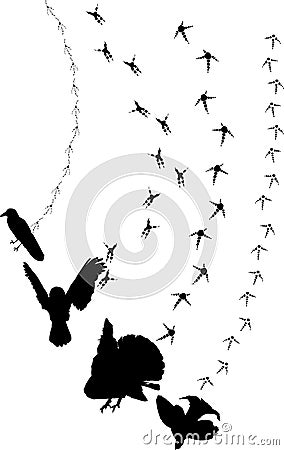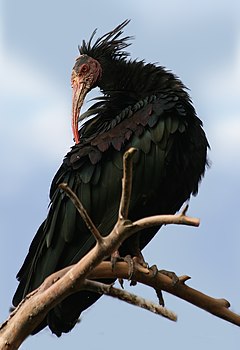| View previous topic :: View next topic |
Wile E. Coyote
In: Arizona
|
|
 |
|
So a pigeon is the generic term for all "young" ie domesticated "tricked" birds.
The real blind spot of orthodoxy, (it will never see these bird towers and their link to tree clearance and managed environments) is this obsession on pagan buildings (normally round) occupied solely by humans. As soon as that possibility is lost, a structure either becomes ritual or, err, just another set of irregular postholes, maybe a cattle shed. etc....
|
|
 |
|
 |
|
Wile E. Coyote
In: Arizona
|
|
 |
|
You dont like it?
Pagan=Pigeon
| online wrote: |
late 14c., from Late Latin paganus "pagan," in classical Latin "villager, rustic; civilian, non-combatant" noun use of adjective meaning "of the country, of a village," from pagus "country people; province, rural district," originally "district limited by markers," thus related to pangere "to fix, fasten," from PIE root *pag- "to fix" (see pact). As an adjective from early 15c.
|
|
|
 |
|
 |
|
Mick Harper
Site Admin

In: London
|
|
 |
|
|
A pigeon in gambling circles is a palooka, a novice, a mark, a patsy etc
|
|
 |
|
 |
|
Wile E. Coyote
In: Arizona
|
|
 |
|
| Mick Harper wrote: | | A pigeon in gambling circles is a palooka, a novice, a mark, a patsy etc |
OK stool pigeon?
|
|
 |
|
 |
|
Ishmael

In: Toronto
|
|
 |
|
| Wile E. Coyote wrote: | | The real blind spot of orthodoxy, (it will never see these bird towers and their link to tree clearance... |
Tree clearance? What are you talking about?
| ...this obsession on pagan buildings (normally round) |
Round buildings? Like round "Templar" churches? What are you talking about?
|
|
 |
|
 |
|
Wile E. Coyote
In: Arizona
|
|
 |
|
| Ishmael wrote: | | Mick Harper wrote: | | The Rook piece was originally a chariot, but became a tower when it moved to the west. | |
I have my suspicions that the game of Chess is very modern and its history was a marketing invention devised by enthusiasts. |
The "first" game was probably something like knucklebones.... dice, cards, and chess come later.
|
|
 |
|
 |
|
Wile E. Coyote
In: Arizona
|
|
 |
|
| Ishmael wrote: |
Round buildings? Like round "Templar" churches? What are you talking about? |
Archaeologists uncover post holes and then imagine timber structures that were built using these holes. The assumption is that your ancient Brits tended to live in smallish group of single storey roundhouses So any circular group of postholes generates a lot of excitement.
Your average archaeo is not looking or thinking about a bird tower. (in fact, nobody other than Wile appears to be trekking down this route).
|
|
 |
|
 |
|
Tilo Rebar

In: Sussex
|
|
 |
|
Brilliant Wile! A BC homing pigeon messaging exchange in every village.
A complex written language isn't needed to make a messaging system useful. Just a simple set of symbols with agreed meanings (similar to runic perhaps).
|
|
 |
|
 |
|
Hatty
Site Admin

In: Berkshire
|
|
 |
|
Writing symbols were 'invented' by Hermes from the flight of birds according to Greek mythology; Ogham, invented by Ogmios the 'Celtic god of eloquence' (Hermes?), looks like prints left by birds or animals

The marks are rather confusingly similar but would be easy to read for anyone knowledgeable about tracks

|
|
 |
|
 |
|
Boreades

In: finity and beyond
|
|
 |
|
Aberfeldy's work, especially on hunting, might suggest that the earliest Ogham symbols were invented by hunters to describe the direction and distance to find game.
http://aberfeldy.wikidot.com/chapter:7
|
|
 |
|
 |
|
Wile E. Coyote
In: Arizona
|
|
 |
|
| Hatty wrote: | Writing symbols were 'invented' by Hermes from the flight of birds according to Greek mythology; Ogham, invented by Ogmios the 'Celtic god of eloquence' (Hermes?), looks like prints left by birds or animals
|
When you are tracking you also look out for dung.
|
|
 |
|
 |
|
Hatty
Site Admin

In: Berkshire
|
|
 |
|
The first symbol in the Egyptian alphabet is h b u, or ibis, represented by the head of Thoth (the Egyptian Hermes who wielded the 'feather of Maat') who was said to have invented writing

typically with the moon above his head (in a dish or boat?)

The story of the ibis is reminiscent of other formerly ubiquitous birds such as the passenger pigeon. Now extinct in Egypt, it's not clear where ibises came from, though they seem to been fairly well-established across Europe, north Africa and the Middle East judging from archaeological remains.
The most intriguing sub-species is the Northern Ibis also known as hermit ibis or, in German, waldrupp meaning 'forest crow' perhaps because of its black feathers but why 'forest' when ibises are associated with dry arid land? At first glance, it's not unlike a cormorant/sea crow

and notice the red legs and bill a la choughs (the red colour comes through as chicks mature).
The birds inhabited semi-arid steppes, unlike the sacred ibis which was described as a marsh bird, and nested on cliff ledges, also on castle turrets. It vanished from Central Europe about 300 years ago but just about survives in Morocco as well as on the Syrian steppes. Its religious connotations remain it seems
| Religious traditions helped this species to survive in one Turkish colony long after the species had disappeared from Europe, since it was believed that the ibis migrated each year to guide Hajj pilgrims to Mecca. |
They were long considered to be mythical birds because of their near-extinction.
|
|
 |
|
 |
|
|
|
|
 |
|
| Wile E. Coyote wrote: |
Your average archaeo is not looking or thinking about a bird tower. (in fact, nobody other than |
That the Greek 'pyrg' which apparently translates to tower, perhaps as you propose may have originated as bird roosting towers, presumably along major travel routes.
Also it seems later to have acquired the meaning of fort or something akin such as port or station (eg. pyrgi circa 600 BC, on the coast near Rome). Moreover the very common 'burg/borg/pyrgos' seen regularly featured along the ancient roads at roughly 10-15 miles, thinning out to upto 50+ miles in remote parts where traffic had thinned out, possibly represent the latter..
But as I posed earlier - How and when did 'pyrg' get transliterated into the Germanic and other languages, including Persian, Maghreb, Levant etc?
Greek traders for the latter seems plausible, but for Northern Europe is less obvious.
|
|
 |
|
 |
|
Hatty
Site Admin

In: Berkshire
|
|
 |
|
|
Pyrgi is a land-fire, from 'pyr' meaning fire and 'gi' earth, land, ground. It may be that the sense of a tower arose as it were from earlier beacons.
|
|
 |
|
 |
|
Tilo Rebar

In: Sussex
|
|
 |
|
| Hatty wrote: | Writing symbols were 'invented' by Hermes from the flight of birds according to Greek mythology; Ogham, invented by Ogmios the 'Celtic god of eloquence' (Hermes?), looks like prints left by birds or animals
 |
Not seen this before - thanks Hatty.
Look like this developed out of some sort of tally system for counting. There are 10 symbols on the left.
|
|
 |
|
 |
|
|